 Mysteries
Mysteries  Mysteries
Mysteries  Creepy
Creepy 10 Scary Tales from the Middle Ages That’ll Keep You up at Night
 Humans
Humans 10 One-of-a-kind People the World Said Goodbye to in July 2024
 Movies and TV
Movies and TV 10 Holiday Movies Released at Odd Times of the Year
 Politics
Politics 10 Countries Where Religion and Politics Are Inseparable
 Weird Stuff
Weird Stuff 10 Freaky Times When Famous Body Parts Were Stolen
 Miscellaneous
Miscellaneous 10 Interesting Things Manufacturers Stopped Making and Why
 Gaming
Gaming 10 Funny Tutorials in Games
 History
History 10 Fascinating Little-Known Events in Mexican History
 Facts
Facts 10 Things You May Not Know about the Statue of Liberty
 Mysteries
Mysteries 10 Devastating Missing Child Cases That Remain Unsolved
 Creepy
Creepy 10 Scary Tales from the Middle Ages That’ll Keep You up at Night
 Humans
Humans 10 One-of-a-kind People the World Said Goodbye to in July 2024
Who's Behind Listverse?

Jamie Frater
Head Editor
Jamie founded Listverse due to an insatiable desire to share fascinating, obscure, and bizarre facts. He has been a guest speaker on numerous national radio and television stations and is a five time published author.
More About Us Movies and TV
Movies and TV 10 Holiday Movies Released at Odd Times of the Year
 Politics
Politics 10 Countries Where Religion and Politics Are Inseparable
 Weird Stuff
Weird Stuff 10 Freaky Times When Famous Body Parts Were Stolen
 Miscellaneous
Miscellaneous 10 Interesting Things Manufacturers Stopped Making and Why
 Gaming
Gaming 10 Funny Tutorials in Games
 History
History 10 Fascinating Little-Known Events in Mexican History
 Facts
Facts 10 Things You May Not Know about the Statue of Liberty
10 Most Influential Things To Have Happened In A Bathroom
Some of the most important events in history have occurred in the bathroom. Although the bathroom is traditionally a place of privacy, it has also been the location of many events that are interesting or have changed history.
10 The Library Of Alexandria Was Destroyed
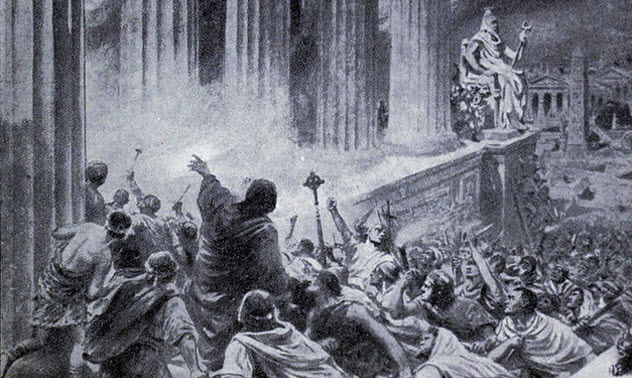
The Library of Alexandria was possibly the greatest institution of knowledge in history. It was also the first library to allow almost universal use: Scholars from all walks of life were allowed to study its contents. But centuries of looting and censorship destroyed this great library, not Julius Caesar as many believe.
Its complete destruction stretched over a long period of time. First was the attack by Julius Caesar, which probably didn’t do much harm to the library. In AD 272, another attack by Emperor Aurelian severely damaged the Library of Alexandria. It was repaired once again, but religious riots in 391 and 415 further damaged it. With each attack, more texts were either stolen or destroyed.
However, it wasn’t only violence that destroyed the great Library of Alexandria. When the Dark Ages arrived, money became tight in the city, and a large library seemed like a waste.
Scholars no longer came to the library because Alexandria was in a continual state of violence. In 639, the Arab armies conquered Alexandria. To make some use of the mostly Christian scrolls and books in the library, the contents were burned to heat 4,000 public baths. There were so many books that it took six months to go through them all. The final destruction of the Library of Alexandria occurred to heat the bathing stalls.
9 George II’s Death Changed Cardiology
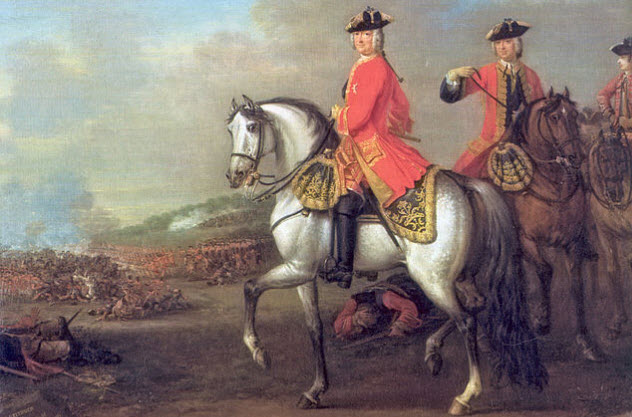
On October 25, 1760, aging British King George II woke up and took his glass of chocolate as he usually did. Soon after, George II went to the bathroom. After a while, his valet heard a noise and jumped into action.
He immediately went to George’s bathroom where he found that the king had died straining on the toilet. After his death, the doctor in charge of George’s embalming wrote the first description of the heart condition known as “aortic dissection.”
Aortic dissection is the most lethal and common aortic condition. It occurs when the aorta ruptures and blood spills into the pericardial sac. For a long time, there was no treatment and no known cause. However, the embalmer kept such an extensive record of George II’s condition that he provided doctors with a template for investigating aortic dissection.
In George’s day, there was no effective treatment for aortic dissection. But management and surgeries now give some hope to those who have the condition. To maximize the chance of survival, the condition should be caught in its early stages.
The foresight of George II’s embalmer to record his findings caused a once silent and uncontrollable killer to be researched and more effectively managed. If George II hadn’t died straining on the toilet all those centuries ago, many more lives would be lost today.
8 Beethoven’s Inspirations

While writing his famous symphonies, Ludwig van Beethoven adhered to a strict schedule, which included some unusual habits to aid his creativity. His most unusual habits involved bathing, as described by his secretary Anton Schindler in the biography Beethoven As I Knew Him:
Washing and bathing were among the most pressing necessities of Beethoven’s life. [ . . . ] If he did not dress to go out during the morning working hours, he would stand in great deshabille at his washstand and pour large pitchers of water over his hands, bellowing up and down the scale or sometimes humming loudly to himself. Then he would stride around his room with rolling or staring eyes, jot something down, then resume his pouring of water and loud singing.
According to Schindler, Beethoven was in “deep meditation,” but the bizarre display left his servants laughing. When this happened, “the master” became angry because his thoughts were being disturbed.
Often, the water spilled down the floorboards into other rooms, leading to conflicts with his landlords. Beethoven was an unpopular tenant, and despite being a musical genius, his fellow tenants often refused to put up with his bathing habits.
7 Elvis Presley’s Death Changed The Music World

In August 1977, Elvis Presley was relaxing at Graceland, his beloved Memphis mansion. At 42, he was heavily addicted to prescription drugs. Overweight and in poor physical shape, Elvis was a ticking time bomb. His time finally came one night after he went to the bathroom, where he stayed for several hours.
After frantically trying to speak to Elvis through the bathroom door, his manager finally entered and discovered that the singer had died. His death came as a shock to his legion of fans, sparking a media circus to tell the story that has never seemed to completely die.
Especially in American culture, Elvis achieved an even more mythic status after he died than he had while he was alive. There have been thousands of Elvis impersonators and tons of Elvis memorabilia. But his millions of adoring fans are the ones who keep Elvis alive, even in death.
6 Napoleon Bonaparte’s Bath
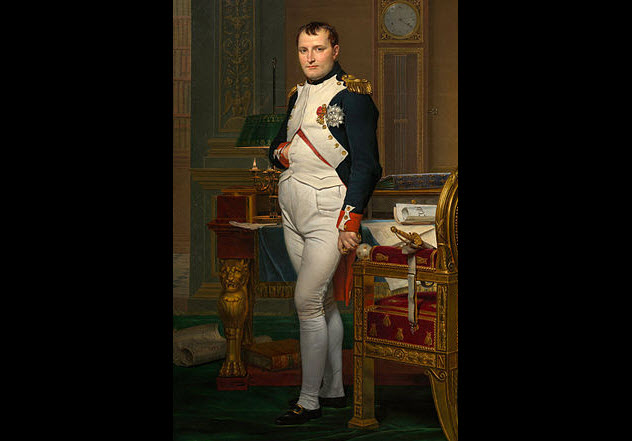
One of the key events in early American history, the Louisiana Purchase doubled the size of the United States. If Napoleon Bonaparte hadn’t been willing to sell the Louisiana Territory, American history would have been quite different. However, his reasons for selling the territory are just as important to history. Needing money to finance his wars, he considered the Louisiana Territory to be a white elephant.
To create a political dynasty in Europe, Napoleon installed his family members in powerful positions in many of his conquered countries. Two of those family members, his brothers Joseph and Lucien, were furious when they discovered that Napoleon had decided to sell Louisiana without telling them.
When they went to his palace to confront him, Napoleon was bathing. The brothers barged in anyway and demanded to know why Napoleon would make such an important decision without their knowledge. When Joseph said that he would oppose the deal, Napoleon accused him of being “insolent.” He then flailed back in the tub, purposely soaking his brothers with water.
Joseph left to change, but Lucien said to Napoleon: “If I weren’t your brother, I would be your enemy.” Enraged, Napoleon grabbed Lucien’s snuffbox, threw it to the ground, and smashed it. If Napoleon’s brothers had gotten their way, the Louisiana Territory would not have been sold. There’s no telling how different the destinies of France and America would have been.
5 Uesugi Kenshin’s Mysterious Death
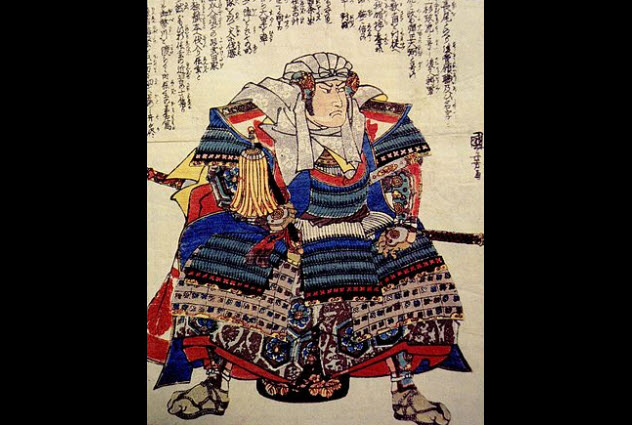
Uesugi Kenshin was the most powerful warlord during the Sengoku period of Japanese history. A mighty warrior who was seemingly impossible to beat, Kenshin was the single greatest obstacle to Oda Nobunaga, one of the great unifiers of Japan. Kenshin was feared by virtually every other leader in Japan because of his skills in martial arts and other forms of fighting. Today, he is still widely remembered in Japan for his prowess on the battlefield.
In 1577, Kenshin mounted a campaign to assault Nobunaga and take his territory. All of Japan was watching, fearful of what would happen if Kenshin defeated Nobunaga, the most powerful daimyo (similar to a feudal king) in Japan. Known as “the Dragon of Echigo,” Kenshin was almost guaranteed to win, even though Nobunaga was a formidable opponent.
Kenshin and Nobunaga had different goals: Kenshin wanted to rule Japan by himself while Nobunaga wanted to unite Japan and incorporate European ideas into the culture. As they prepared for battle, something happened that would change the history of Japan forever.
Kenshin died in the lavatory before he could attack Nobunaga. Some say that Kenshin died from the effects of heavy drinking while others claim that he had stomach cancer. Still others believe that Kenshin was killed by an assassin hiding in the lavatory.
When Nobunaga heard the news of Kenshin’s death, he is said to have remarked: “Now the empire is mine.” Upon Kenshin’s death, Nobunaga did indeed gain control of all of Japan and created one of the most prosperous and productive periods in Japanese history.
4 The Murder Of Agamemnon
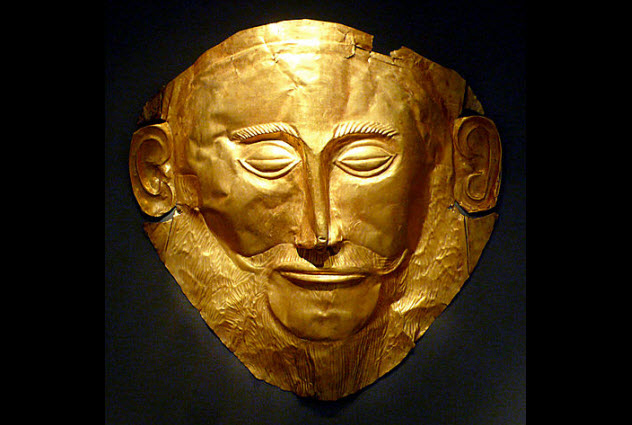
According to Greek mythology, the legendary Agamemnon was the ruler of the kingdom of Mycenae. Agamemnon is featured prominently in Homer’s Iliad as a brave warrior, but he was also arrogant and proud. In fact, his story is often seen as a warning against hubris, or excessive pride.
Agamemnon was one of two sons born to Atreus, the king of Mycenae. Atreus was murdered by his brother, so Agamemnon and his brother fled to Sparta and joined the army there. The ruler of Sparta gave his daughters to the brothers as wives, but Clytemnestra, the daughter who was to marry Agamemnon, was already married.
Agamemnon murdered her husband and married her. After a time, Agamemnon returned to Mycenae and killed his uncle, reclaiming the throne. Meanwhile, Agamemnon’s brother married the Spartan king’s daughter Helen, who was said to be the most beautiful woman in the world.
But Paris, the prince of Troy, went to Sparta, claimed Helen as his wife, and returned with her to Troy. When the kings of the other Greek kingdoms agreed to go to war with Troy to rescue Helen, Agamemnon was chosen to lead the combined armies. Before he sailed to Troy, however, he insulted the goddess Artemis by saying that he was a better hunter than she was and killing a sacred stag. Artemis took the winds from his ships’ sails, so the warriors couldn’t reach Troy.
A seer told Agamemnon that he could please Artemis by sacrificing his daughter, Iphigenia. He tricked his wife into giving him their daughter, killed her, and then went to Troy. After nine years of war, he finally defeated the Trojans. Agamemnon sailed back to his wife, Clytemnestra, who had taken a lover.
As revenge for sacrificing their daughter, Clytemnestra decided to kill her husband. When Agamemnon returned, she prepared a bath to cleanse him. After he got out, Clytemnestra wrapped him in a garment in which he couldn’t move. Then her lover came in and brutally killed Agamemnon.
3 The Biblical King Eglon Was Killed In His Bathroom Chamber
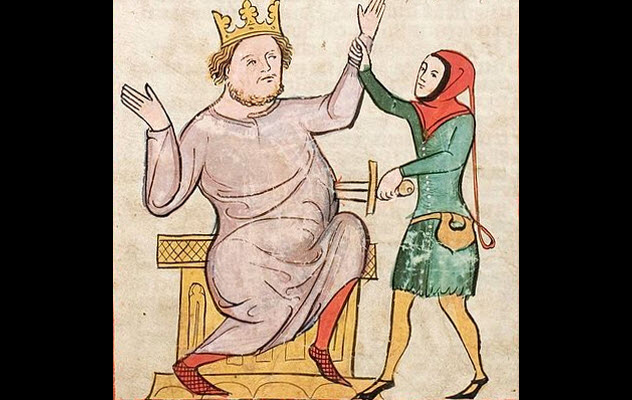
Royalty in ancient history often had ingenious plumbing that allowed them comfort while they did their business. According to tradition, they often greeted their visitors in the bathroom. Although we wouldn’t want others to see us in the bathroom today, royalty in those times wanted to show that they were superior to their guests. Apparently, the best way to convey that message was to greet guests in the most awkward of places—the bathroom.
In the third chapter of Judges, the Bible says that an Israelite named Ehud was called by God to deliver the Israelite tribute to the obese Moabite king Eglon. When Ehud arrived, Eglon was on the toilet. Ehud entered the bathroom and stabbed Eglon to death on the toilet. As he left, Ehud locked the bathroom door.
When Eglon’s courtiers finally got in, the king was dead. Ehud’s daring move freed Israel from the Moabites.
2 George Smith’s Killing Spree
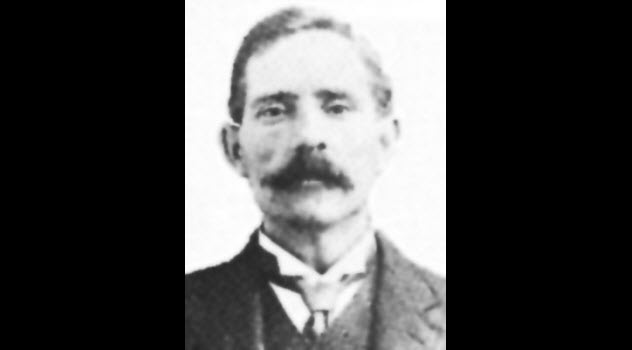
Known popularly as the “Brides in the Baths” murderer, George Smith was such an infamous killer that Madame Tussaud’s House of Horrors maintained an exhibit of him for years. His 1915 trial for murder made Smith an instant celebrity but not for the right reasons. His case was one of the first to be solved by forensic science.
Smith habitually married wealthy, young women who couldn’t find suitors. Then he would drain their bank accounts and leave them. However, his wife Bessie Mundy was more of a challenge. When Smith learned that her money was locked away by trustees, he left her. After they met again, Mundy told Smith that she now had direct access to her inheritance. Soon after, she was found drowned in her bathtub, with her husband as the sole heir of her fortune.
Smith went through multiple wives, killing two more by drowning them in the bathtub. Eventually, he was arrested and tried for murder. There was no direct evidence, but pathologist Dr. Bernard Spilsbury used primitive forensic science to convince the jury of Smith’s guilt.
Spilsbury produced one of the bathtubs in which one of the young women had been killed. He then found a model who agreed to serve as the mock victim. By putting her in the bath, lifting her feet in the air, and causing water to rush into her nose, Spilsbury showed how easily Smith could have drowned his strong, healthy victims.
This sort of reasoning and evidence had never been used before, but it was enough to sway the jury to vote guilty. Smith was executed on August 13, 1915. Spilsbury’s use of forensic science forever changed the way we solve crimes.
1 Jean-Paul Marat’s Assassination
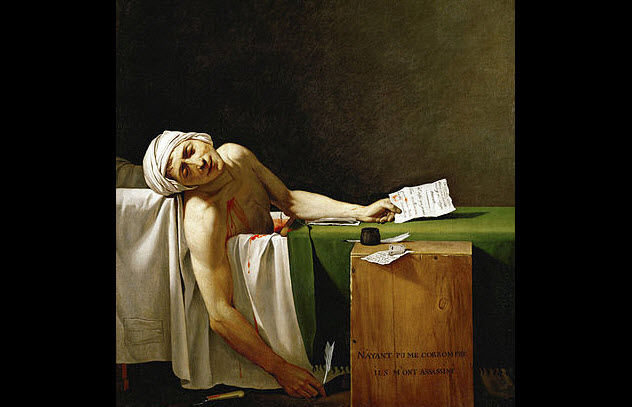
Jean-Paul Marat was one of the most important journalistic voices of the French Revolution. Originally a supporter of the monarchy, Marat eventually became an advocate for extreme violence, urging his readers to kill anyone who opposed the revolution. But his outspokenness cost him his own life.
Marat suffered from severe skin infections. At the time, the only cure was taking frequent baths, so Marat began to do the majority of his writing there. He also received visitors while in his bath, which left him vulnerable to attack.
In 1793, Marat was a target of the conservative Girondin faction. After his acquittal in a controversial political trial, he reached the climax of his career. The Girondins were angry that their greatest enemy was free, so Girondin follower Charlotte Corday went to Marat’s home to speak to him on July 13.
Corday murdered Marat in his bath, making him a martyr whose name was eventually given to 21 French towns. To show solidarity between the French and the Russian revolutions, the Soviet navy also named one of their first battleships after Marat.
Gordon Gora is a struggling author who is desperately trying to make it. He is working on several projects, but until he finishes one, he will write for Listverse for his bread and butter. You can write him at [email protected].








